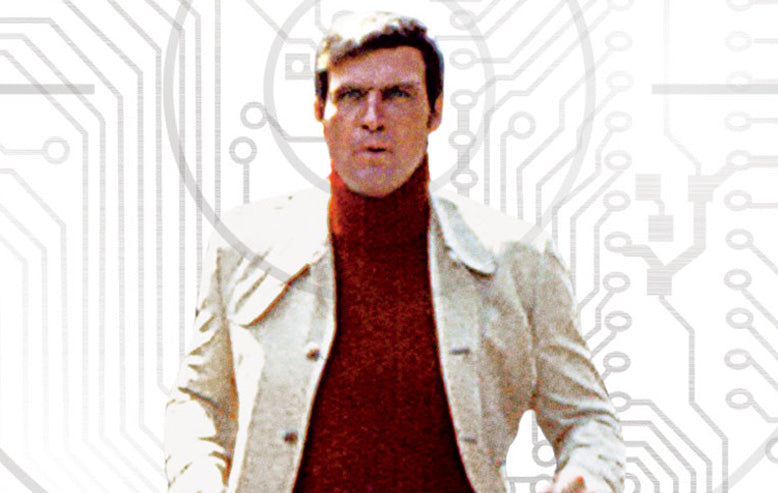
When interviewed more than three decades after the fact, Harve Bennett remembered getting a call from Frank Price, then head of Universal Television, asking him to produce The Six Million Dollar Man as a weekly series. Bennett told Price he’d have to think about it. “Well, don’t think too long,” said Price, “because you have to be on the air in six weeks.”[1]
In truth, the studio announced Bennett as the show’s executive producer on November 27, 1973—seven weeks and five days before The Six Million Dollar Man was slated to premiere on ABC.[2] But that was still an incredibly tight window to write, prep, film, edit, dub, and deliver an hour long episode of action adventure, with a new episode due almost every week for fifteen weeks (the network mercifully preempted the series twice in its first year).
To put this insanity in context, when Bennett started work producing The Mod Squad in 1968, it was six and a half months before the first episode was due to air.[3] And that was a series without the added format considerations of The Six Million Dollar Man, which combined globe-trotting action adventure with science fiction.
On top of all this, when Bennett agreed to take charge of The Six Million Dollar Man, he wasn’t just signing on to oversee a series format that had already been established. The Six Million Dollar Man had three separate pilot telefilms at this point, but they were from producers with two very different approaches to the material. It was Bennett’s job to reconcile the two into something that would work as a weekly series.
Deadly serious, the first telemovie focused on the psychology of astronaut turned test pilot Steve Austin (Lee Majors). After barely surviving a harrowing plane crash that takes three of his limbs and an eye, he makes a thwarted suicide attempt and battles serious depression. Austin eventually accepts the six million dollars of bionic enhancements that save his life, but not before multiple allusions to being Frankenstein’s monster.
Produced by Glen Larson (Manimal, Automan), the second and third telefilms completely retooled the series as a lighthearted James Bond knock-off. Steve Austin became a government agent sporting a tuxedo and firing off quips as he deals with international supervillains. A new theme song performed by Dusty Springfield had some truly cheesy lyrics.
The initial telefilm had been a success—landing at #10 in the Nielsen ratings the week it aired.[4] But the second and third telefilms had seen a huge drop-off in viewership, ultimately placing at #52 in the Nielsen ratings.[5]
After screening all three pilots, Bennett arrived at the same conclusion as many in the audience. “Lee Majors is not James Bond,” he recalled decades later. “They had put him in a blue ruffled tuxedo shirt, Monte Carlo was a background, and it just didn’t work.”[6] However, one element from the Larson telefilms would be retained: Richard Anderson as Oscar Goldman, who’s charming yet serious performance was so often the glue that would keep The Six Million Dollar Man (and later The Bionic Woman) together.
All of which brings us to the show’s premiere episode, “Population: Zero,” which is a remarkable achievement given the production realities that surrounded it. Written by Elroy Schwartz (with uncredited rewriting by Harve Bennett and producer Lionel E. Siegel) and directed by Jeannot Szwarc (a year before he directed the horror feature Bug for William Castle), the episode efficiently reestablishes the core elements of the series while also ably executing an engaging science fiction premise involving sound waves as a weapon.
Why do we love it? Let’s get into some specifics from this episode.
“Stay Away From This Town!” — A Smashing Teaser
The episode begins with a chilling and efficient teaser (from first shot to credits, it’s 3 minutes and 23 seconds). A series of shots reveal (1) a child’s doll, eerily swaying back and forth on a swing set, (2) a woman lying motionless underneath fresh laundry on a clothesline, and (3) a tumbleweed, which the camera tracks to reveal main street in Norris, California (population: 23). But rather than a charming little town, we see that every last inhabitant has fallen dead in their tracks.
Genre stalwart Paul Carr (Star Trek, The Invaders, Ben) pulls up to the scene, and is shocked by the devastation before him. “The whole town, they’re just lying all around me here,” he tells the dispatcher, his voice trembling. In less than a minute, he, too, collapses, but not before yelling into the radio, “Stay away from this town!”
We then see a gray-haired man (special guest star Don Porter, who would go on to play a different character in three episodes of The Bionic Woman) dispassionately viewing the scene from a surveillance room. “Our message has been delivered,” he says. “Now let’s see what the establishment does about it.” From there, it’s a smash cut to the opening credits. Speaking of which...
“We can rebuild him” — A Timeless Credits Sequence
The main titles are now famous (Harve Bennett even gets in the first line of voice over: “Steve Austin, astronaut, a man barely alive...”), but they were newly created for this episode. A marvel of television editing (the creation of this sequence is profiled in “An Iconic Opening,” a featurette found on Season 1, Disc 5), the sequence lays out everything you need to know about the series in just sixty seconds.
By dropping the song and lyrics used for the second and third telefilms, it makes it clear that the series, while still action-adventure, won’t be quite as frivolous in tone.
Pocket Bionics
At the top of act one, we’re reintroduced to Steve in his garage, working on a dune buggy, which is a nice way to dramatize that Steve has a life outside of his work—and to show off his super strength when he bends a metal pipe with his bionic arm. Kenneth Johnson, soon to join the series, would nickname this use of bionics in everyday life “pocket bionics.”
“Steve Austin, Astronaut”
On the outskirts of town, Steve meets Dr. Chris Forbes (Penny Fuller), whom he is surprised to learn is a woman. This stock type was a regrettable artifact of 1950s B-movies even in 1974; The Six Million Dollar Man holds up surprisingly well, but was never a leader in gender politics. Dr. Forbes shows Steve a series of photographs of the town—economically lifted from Universal’s then recent adaptation of The Andromeda Strain (1971). There are no signs of a gas leak, radiation, or water pollution. To confront this unknown threat, Steve has ordered up something from NASA. “It’s a space suit...the best protection there is,” he says.
The two guys from NASA who deliver the suit are in disbelief that the space suit could fit Austin. It was custom-made for an astronaut who walked on the moon “a couple of years ago.” The suit, of course, fits. “I didn’t catch your name,” says one of the NASA guys. “Well, it’s on the suit,” Steve says (“S. Austin” reads the name label) and only then does the NASA guy recognize him.
The series would walk a fine line about Steve’s NASA backstory, establishing that he’s famous for being an astronaut, but not Neil Armstrong famous—which gives the series just enough cover for audiences to suspend their disbelief that Steve is able to work as an undercover agent.
“They’re Alive!” — A Great Reversal
When Steve, now donning his pressurized space suit, walks into Norris, Oliver Nelson’s music is somber rather than heroic, emphasizing the apparent tragedy in town. But this is a clever bit of misdirection that leads to a great reversal. Minutes after Steve arrives in town to survey the “bodies,” everyone in town comes back to life and slowly stands up. “They’re alive! They’re all alive!” shouts Steve as we cut to commercial. Imagine not wanting to tune back in after that cliffhanger.
Audiences at the time sure stuck around to see how it ended. “Population: Zero” scored a 38 share and a 24.2 rating for its Friday debut, which “spearheaded the web’s
“A Man’s Got To Know His Limitations”
The telefilms had quickly escalated Steve’s abilities and the capabilities of bionics in general. By “The Solid Gold Kidnapping,” government scientists could, for example, transfer the memories of a dead man into a living host.
Harve Bennett wisely recognized that if bionics kept going in this direction, it would be a recipe for diminished drama and narrative absurdity. So, “Population: Zero” set limits for Steve’s super strength and super-sight. But, not only that, it established that under certain conditions, Steve’s bionics would become a liability. Namely, in freezing cold, Steve’s bionics stop functioning altogether.
The villain in this episode utilizes this to his advantage by locking Steve up in a commercial freezer. Steve is able to escape through a little ingenuity that shows he’s more than his bionic enhancements (he cuts a gas pipe, turns it into a blow torch, and uses it to cut his way out). But once he’s out of freezing conditions, the full extent of his bionic abilities only return slowly as his body temperature increases over time.
Slow Motion Bionics
Finally, “Population: Zero” settles on slow motion as a way of dramatizing Steve’s bionic strength and speed. The telefilms had used slow motion intermittently, but this episode settles on a vocabulary that will be easy to understand week-to-week. From now on, when things shift into slow motion, we’re seeing Steve’s bionics at work. However, the show’s famous sound effects for these sequences would take a few more episodes before they were set in stone.
In “Population: Zero,” slow motion is used when Steve overturns a crashed car upon first entering the town. More dramatically, it’s deployed when Steve runs while his frozen bionics slowly come back to life, frantically pulls a large metal fence post out of the ground, and throws it like a javelin to thwart the villain’s megalomaniacal plans. This latter sequence effectively cross-cuts from Steve in slow-motion, with the sound of his heart-beat pounding on the soundtrack, to other characters at normal speed, until it is violently punctuated by two shots of the flying fence post. In one shot, it flies balletically through the open air in slow motion. But in the very next shot, we are inside the villain’s van with the sonic weapon at normal speed, and the fence post smashes through the wall, causing the van to explode.
“Population: Zero,” the first regular episode of The Six Million Dollar Man, first aired on ABC on January 18, 1974, forty-nine years ago this week. The Six Million Dollar Man is now available on Blu-ray from Shout! Factory.
[1] “OSI Mission Debriefing,” The Six Million Dollar Man Blu-ray, season 1, disc 5.
[2] “Bennett at ‘Man’ Hem,” Weekly Variety, November 28, 1973, p.34
[3] “BENNETT TEAMS WITH BARRETT IN PRODUCTION OF ‘MOD SQUAD’,” Daily Variety, March 13, 1968, p.20
[4] “Poor Week For Specs And Pilots; Hope Runs 25th,” Weekly Variety, March 21, 1973, p.35
[5] “1st Half Season Averages,” Weekly Variety, January 23, 1974, p.31
[6] Harve Bennett Interview with Stephen J. Abramson, February 13, 2008. https://interviews.televisionacademy.com/interviews/harve-bennett
[7] “ABC Loads The Program Larder, Gets Quick ‘2d Season’ Lead,” Weekly Variety, January 30, 1974, p.31









